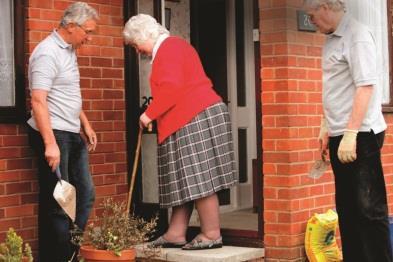Joining up health, housing and care gets patients home quickly and safely in Leicestershire. Cheryl Davenport outlines three projects in the county

Health and care partners in Leicestershire have placed housing support at the heart of their integration programme.
Leicestershire Health and Wellbeing Board’s Housing Offer to Health and Wellbeing report, produced in conjunction with the Chartered Institute of Housing in 2013, was the catalyst for understanding the critical difference housing makes to health and wellbeing. Leicestershire’s better care fund plan responded to these findings, with some exciting new developments implemented over the past 12 months, outlined below.
More from this special report
Supporting discharge for mental health patients
This support scheme to enable mental health patients to settle back into a safe home environment after treatment is a great success. The district, county and city councils, alongside partners in the third sector, are working with Leicestershire Partnership Trust’s Bradgate Unit to support patients who need help with housing concerns. Known as the housing discharge enabler, the scheme:
- places a housing specialist in the Bradgate Unit, to identify and help overcome housing issues so patients can return home as soon as possible after treatment;
- understands and tackles the additional barriers to accommodation faced by patients - for example, due to stigma; and
- provides support once they are home, including help with furniture and benefits.
As well as the positive impact on the patients themselves, the scheme is on track to reduce the cost of housing related delays at the Bradgate Unit. A formal evaluation is to quantify the impact this has had is underway and is planned for 2015-16.
Examples of people helped by the scheme include:
- Mr L, who was able to live alone for the first time, following help to find affordable housing and community support.
- Mr B, who was provided with council accommodation and furniture.
- Mr J, who, due to changes in his circumstances, was struggling to pay the rent and by the time he was admitted to hospital had accrued thousands in arrears, which was a major factor in the deterioration of his mental health. After a short stay in hospital, Mr J was able to return home, initially to his original address, but was swiftly able to move to more a suitable and affordable home, supported by the housing to health project. This support continued post-discharge to help with housing and employment benefits. Had these issues not been resolved, there was a significant risk of a readmission to hospital.
Keith Cunliffe on perfect weeks in health and social care
It won’t be news to anyone that councils and partners across the public sector are experiencing some unprecedented challenges. Revenue reductions and rising demand mean we cannot continue to maintain the status quo.Nor would we want to. In Wigan, we are increasingly recognising that the way we deliver public services in a place often makes it harder than it should be to deliver what is needed for residents. Services are often still fragmented, with agencies working independently, on different geographical footprints, with different thresholds, assessment criteria and often a focus on single issues.
To test what we could improve by working in a place in a new way, we have been using the concept of the “perfect week”. This is a seven day experiment in which we suspend the usual rules, bring partner agencies together to identify assets in individuals and in communities, and to learn from working differently.

The first perfect week was centred on primary care, helping us to understand how an integrated approach could help improve outcomes for patients visiting a GP practice.
We aimed to test a different way of working based on supporting them with a greater focus on prevention and earlier intervention. For example, key workers accompanied GPs on home visits to identify how the individual and family could be supported beyond the immediate medical need.
The results were compelling. By having a different conversation, it was far easier to identify root cause issues such as debt, housing and social isolation, and identify cost effective ways to help people beyond the prescription pad. GPs appreciated the potential of working within a social model of prescribing, understanding that alternative options are real and accessible in the community.
Based on case studies gathered during this exercise, we used cost benefit methodology to model potential effects from the intervention over a year if the approach were to be rolled out more widely, with the potential for significantly improved outcomes and cost savings to public services. Many of these benefits will be to the NHS through reduced hospital admissions, reduced costs associated to mental health conditions, and reduced GP attendance. This way of working is now at the heart of our wider plans for health and care reform.
Building on this experience, we adopted the perfect week approach again, this time with a focus on children and families and working with three primary schools in one of our most deprived housing estates. Schools see children and families on a daily basis and we wanted to capitalise on this potential as part of the work.
During the week council staff co-located with a wide range of services at the school and extended the opening times, giving staff the permission to work together in a different way that liberated them from referral processes and thresholds.
Again, the results were exciting. We reaffirmed the simple importance of teams across agencies knowing each other, knowing individuals and families, and knowing the resources in the community. A school nurse said to us: “This has reminded me why I came into this role - to make a difference to children and families, not fill in forms.”
We found out that the delivery of services in a more informal community and school venue, close to home, increased engagement. A father accessed employment through a job club, a mother engaged in formal training, and others connected with the community organisations and groups, all as a result of the project.
Again, we used cost benefit analysis to predict how we might benefit from a wider rollout of this approach in terms of outcomes for children and families and cost to public services. The results showed that this kind of approach is the one we want to pursue.
Both perfect week experiments provided us with compelling evidence that doing things differently, joining up public services around schools and GPs in a place is the right direction
to take.
Keith Cunliffe is a Labour cabinet member for adult social care and health for Wigan Council
Housing support at Leicester Royal Infirmary
In December, the scheme allocated a housing support officer to Leicester Royal Infirmary for a two week trial to assess the housing issues affecting acute hospital patients. Forty-two per cent of the patients reported a housing or welfare issue that would impair their ability to go home and remain there safely and comfortably.
‘The team is already finding ways to streamline the often lengthy processes that can occur between agencies’
As a result, a joint initiative has been set up by the three CCGs across Leicester (Leicester City, West Leicestershire, and East Leicestershire and Rutland), Leicestershire and Rutland Association of Local Councils, Leicester City Council, the district councils across the county, Leicestershire County Council and partners in the third sector.
Initially, two full time housing experts were employed at the Royal Infirmary to help people with housing needs, including welfare and benefits advice. Based on the early success of this initiative in improving discharge and reducing re-admissions, the partners have funded a third post. It has also employed a community support worker to help people once they are back at home so they can avoid re-admission.
The Lightbulb housing project
This project, which received a £1m transformation challenge award from the Department of Communities and Local Government, aims to integrate a wide range of housing support into one easy to access service across Leicestershire, demonstrating a clear, positive impact on health and wellbeing.
Blaby District Council hosts the technical housing and grants officers, occupational therapists and adaptations specialists as a co-located team, to integrate these traditionally fragmented services.
‘This project aims to integrate a wide range of housing support into one easy to access service’
The first two pilots, in Blaby and north west Leicestershire, looked at adaptations in the home for elderly people - for example, stair lifts, handrails, or changes to a bathroom. The team is already finding ways to streamline the often lengthy processes that can occur between agencies, causing delays and frustrations for residents and professionals.
Using learning from the adaptations pilot, the rollout will continue into the Hinckley and Bosworth area, where the model will focus on integration with GP practices. Integrating warm homes advice, handyperson services, and hazards/falls prevention are all part of the future vision for Lightbulb.
Cheryl Davenport is director of health and care integration for Leicestershire County Council
Special report: Health, housing and care are successful together
- 1
 Currently reading
Currently readingSpecial report: Health, housing and care are successful together
- 2
- 3




























No comments yet